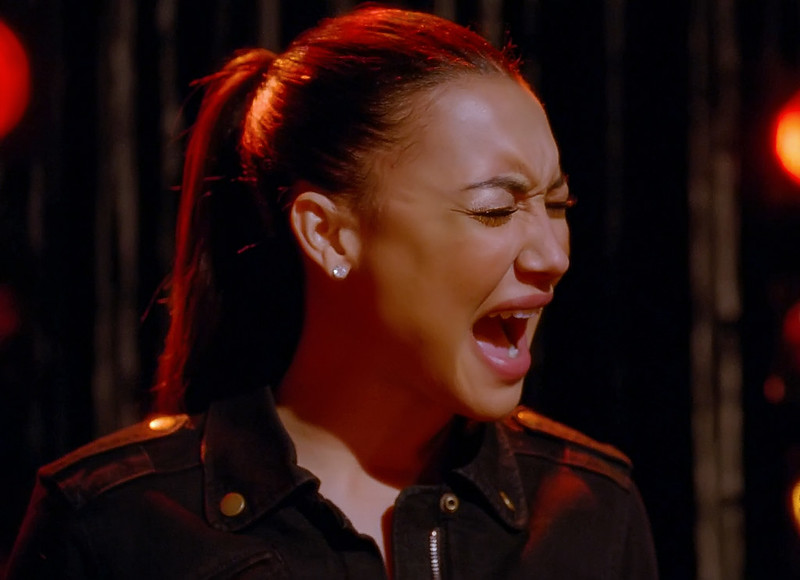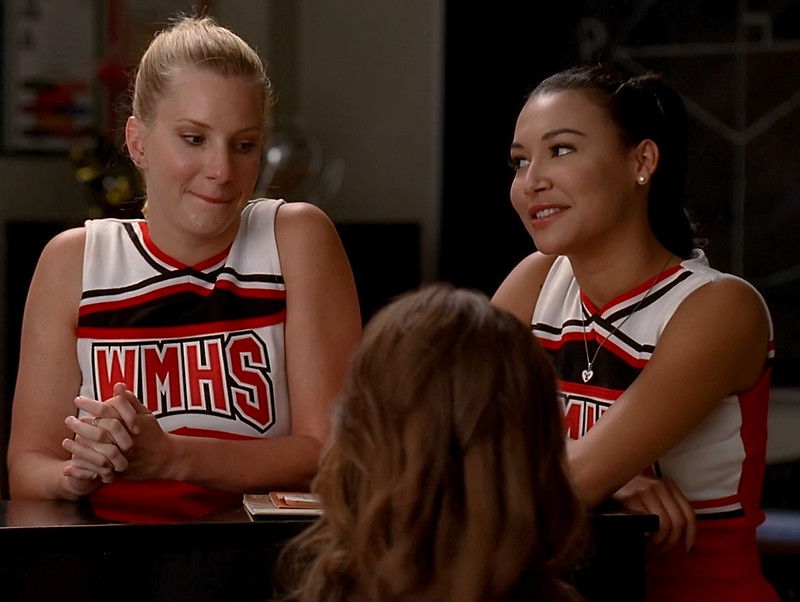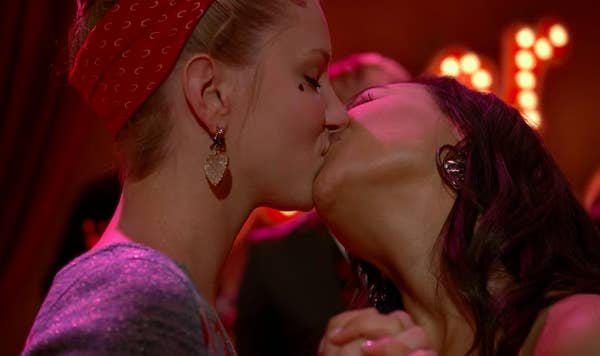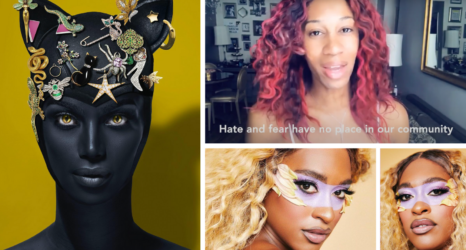
The early 2000s can be described as both the best and worst of times with regard to the portrayal of lesbians and female sexuality in mainstream media. In the TV landscape, although many gay and lesbian centered shows were gaining mainstream appeal—partly due to the success of programs like “Queer Eye for the Straight Guy” and “The L Word”—it almost never accurately presented a picture of female homosexuality for coming-of-age youth.
During the decade, the three biggest networks aimed at kids, teens and young adults were Disney, Nickelodeon and MTV. Of the three, MTV was the only one to show homosexuality on-screen. However, when it came to lesbian and bisexual female representation, it largely presented female queerness in the most stereotypical, sexualized manner possible.
One of the most well-known examples of this was during the 2003 MTV Video Music Awards. During a performance, popstars Madonna, then 45, and Britney Spears, then 21, engaged in what we now know to be a pre-planned “faux-lesbian” kiss onstage in front of over ten million viewers. At the time, that five-second moment sparked backlash, with fellow artist Bette Midler calling the stunt “tacky and irresponsible.“
A few years later, in 2009, a little show called “Glee” premiered on FOX, marking a significant milestone in the lives of LGBTQ+ teens and young adults. The show was often praised for its depiction of teen gay and lesbian characters, especially early on with Kurt’s iconic coming-out scene in the fourth episode of the series.
While this scene and Kurt’s status as a main character (virtually unheard of on cable TV at the time) were significant in terms of LGBTQ+ representation, Kurt was still portrayed as a stereotypical gay man: He loves fashion and musical theater, he’s more comfortable in his friendships with girls and he often engages in “predatory” behavior towards heterosexual character Finn.
Meanwhile, one character who steered away from stereotypes—making many young lesbian women finally feel seen—was Santana Lopez, played by the recently-passed Naya Rivera.
In the beginning of the series, Santana was merely the shallow, sexually promiscuous, mean-girl sidekick to head cheerleader and queen bee Quinn Fabray (Dianna Agron). However, Santana quickly became a fan-favorite for her witty and hilarious one-liners and savage, spicy attitude.

Her strengths, both as a character and musically, were revealed during the episode “Laryngitis” in the form of a duet rendition of Monica and Brandy’s “The Boy is Mine” with Mercedes Jones (Amber Riley). In that moment, Glee fans—a.k.a. “Gleeks”—knew something special was happening.
And they weren’t alone. The show runners also saw new potential for Santana that wasn’t originally intended because of the way Rivera brought the character to life. As Rivera wrote in her autobiography:
“I tried to think of ways I could make Santana stand out, even though she didn’t have any lines [in the pilot]. I figured that if she was the bitchy sidekick, then I was going to make her a megabitch with extra kick … My first line [in the second episode “Showmance”] was a snide, tossed-off ‘get a room’ as I walked by Will [Matthew Morrison] and Emma [Jayma Mays] talking in the hallway. Then the rest is bitchy history.”
— Naya Rivera, “Sorry Not Sorry: Dreams, Mistakes, and Growing Up” (2016)
By season two, the romantic story arc between Santana and fellow cheerleader and BFF Brittany Pierce (Heather Morris) solidified Santana, as well as Rivera herself, as an icon for young lesbians.

In a tribute following Rivera’s death, Glee show runners Ryan Murphy, Brad Falchuk and Ian Brennan recounted how Rivera pushed herself create a realistic depiction of a young, Latina, femme lesbian:
“It was one of the first times an openly lesbian, high school relationship was seen on network television, and Naya understood what ‘Brittana’ meant to the many young women who were seeing themselves represented on television for the first time. Naya always made sure that Santana’s love for Brittany was expressed with dignity, strength and with pure intentions.”
Rivera had shared similar sentiments in her book, recalling how early depictions of Santana and Brittany’s relationship served as queerbait, saying that she and Brittany were only “allowed quick pecks” on screen because “the writers had to assure the network that they were just dipping their toes in the gay pool.”
But over time, the impact of the relationship became clear:
“Like many things that went on to become major plot lines on “Glee,” Brittany and Santana’s relationship started out as a joke [in season one] … At first, [in season two] I was just happy that she was getting a story line … but as that story progressed, we all started to see how much it was resonating with people. It was no longer a joke or a way to spice things up, but something we should take seriously.”
Prior to Santana, lesbians on TV were either relegated to paper-thin stereotypes or hyper-sexualized caricatures seen through the eyes of shallow male leads. In the modern era, far too many queer TV characters meet an untimely demise, as Buzzfeed writer Hannah Marder explains:
“Queer couples (often ones viewers love—like Willow and Tara on “Buffy the Vampire Slayer”—or have just gotten started, like Clarke and Lexa on “The 100″) have their relationships ended by one or both parties dying suddenly and unnecessarily, in a way that often doesn’t further the plot. It’s almost as if queer characters are expendable or the show doesn’t actually know how to write a queer couple.”
Marder also addressed disdain for when queer female characters end a relationship, only to have their sexuality never be addressed again:
“I really loved both Adrianna and Gia on “90210” and Marissa and Alex on “The O.C.,” and both were cut too short. That’s fine—not every relationship needs to last forever. But having these relationships never mentioned again made it feel like Adrianna and Marissa were just going through a ‘phase.’
The shows acted like they were finally going to give some great pansexual or bisexual representation, and then they completely backed away and pretended it never happened. Even though these were actual queer relationships, it still felt like a form of queer-baiting to me.”
And, of course, a conversation about the history of lesbians on TV would be incomplete without discussion of Ellen DeGeneres and her historic coming out on her self-titled sitcom in 1997. After the infamous “Puppy Episode,” the show spent its last season trying to discuss “gay themes,” but it was constantly a battle, as Degeneres told Diane Sawyer in 1998:
“The subjects that we dealt with [on the show] were the subjects that any other show on television deals with. You know, all these things that you go through when you feel something for another person. So, you know, if that’s gay because it’s the same sex that I’m dealing with, then it’s gay … The comfort level of the audience is never going to say ‘C’mon give us some gay stuff; we’re ready for it now.'”
Over a decade later, Santana Lopez and her love story with Britanny became one of the most talked-about story lines on TV. Given the history of LGBTQ+ representation and the popularity of social media, the pressure was there for Rivera’s character to be different from those who came before.
Rivera wrote:
“As each new episode aired, I would get tweets from people thanking me and telling me how important the story line was to them. The writers would get similar praise—and also the occasional death threat from a lesbian warning them that they’d better not mess this up. I think we did a pretty good job.”
Still, Santana’s character was also successful because her sexuality was not her sole defining trait, writes Emily Browne:
“Over the course of three seasons, Naya’s sensitive portrayal of a teenage girl coming to terms with a crush on her best friend had an immeasurable impact on a community of young women who saw themselves reflected in the narrative. They also saw a character who wasn’t just boiled down to their sexuality, but a popular, confident, smart femme who was completely unapologetic about who she was.”
Santana was an inspiration for many young, femme women to embrace their sexual orientation and come out—including me. I always knew I liked girls, but I never believed it would ever be a possibility to be in love with another woman.
When “Glee” first premiered, I was 13 and trying to mask my ever-growing feelings for other women by dating men. I tried to convince myself I wanted this—that this was what I was supposed to do.
When I was 18 and re-watching the second season of “Glee,” one scene in particular stood out to me. In the scene, Santana, Brittany and substitute sex-ed teacher Holly Holiday (Gwyneth Paltrow) are discussing the possibility that Santana and/or Brittany could be a lesbian, to which Santana responds she’s attracted sexually to both men and women. Holly’s explanation of what sexual orientation actually boils down to changed my life forever:
“It’s not about who you’re attracted to, ultimately. It’s about who you fall in love with”
— Holly Holiday, Glee S2E15 “Sexy”
In the years since Glee’s departure from the airwaves, Santana Lopez is still making an impact in the lives of lesbian and bi women. As one of the few lesbian characters to ultimately have a happy ending (Brittany and Santana get married by the end of the series), her story was ground-breaking and impactful from start to finish.

The story of “Brittana” (as fans lovingly called the couple) was a story of real love between two young women that was stronger than anything the world threw at them.
Santana made young femme lesbians feel seen. Santana made me feel seen—and helped me realize that finding real love with another woman was possible.
Thank you. Thank you. A giant lipstick lesbian thank you.
Rivera passed away on July 8 at the age of 33.
Naya Rivera: Rest in power.





